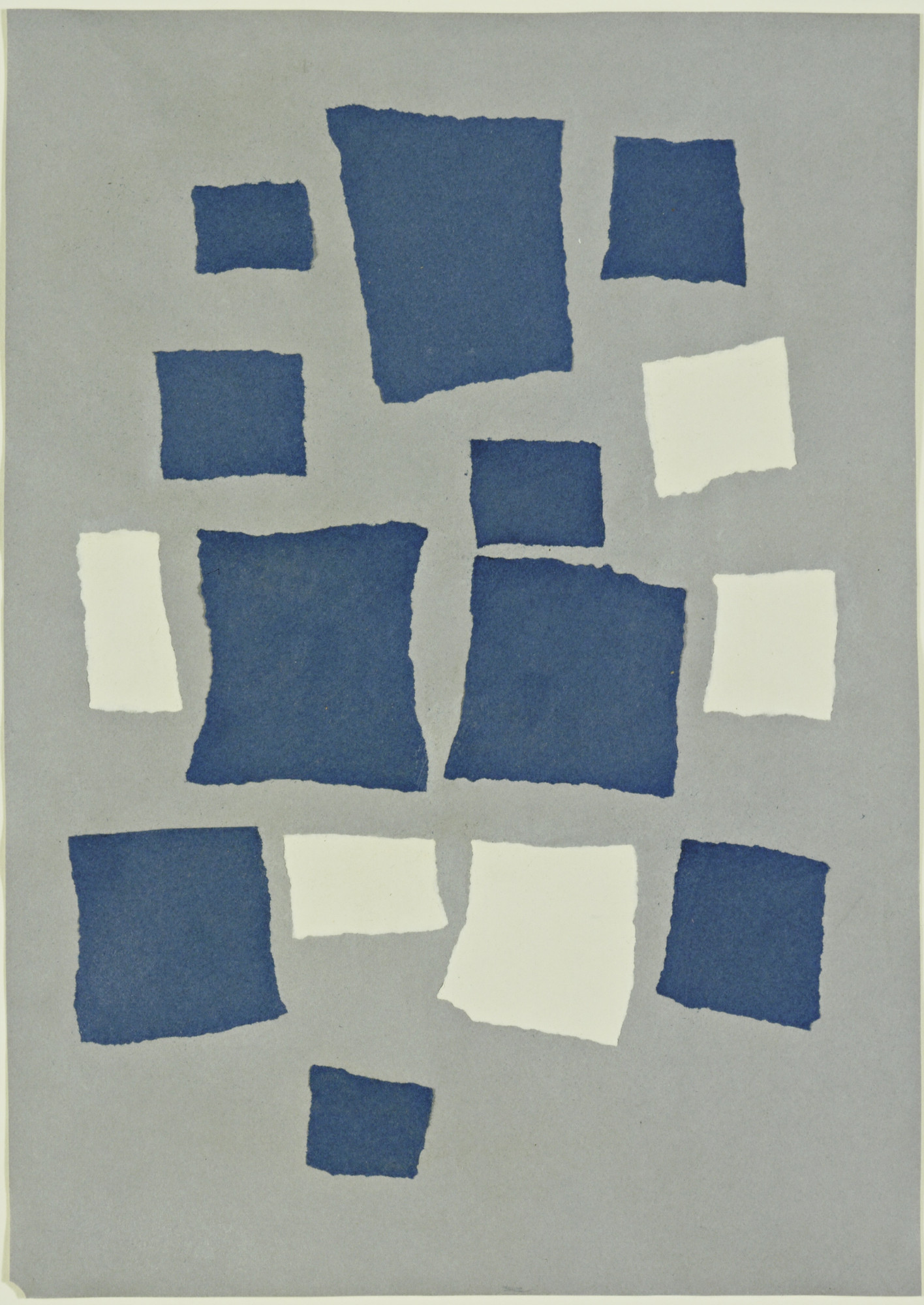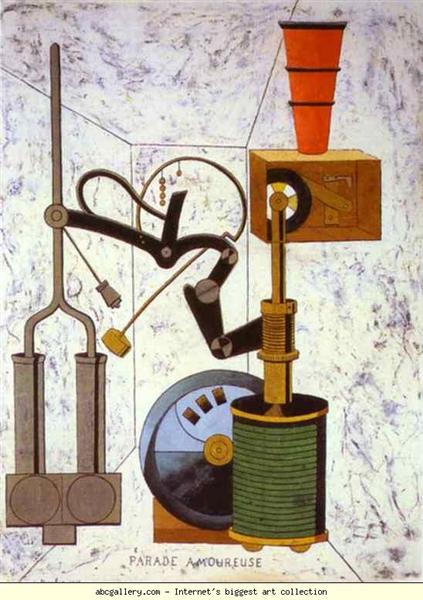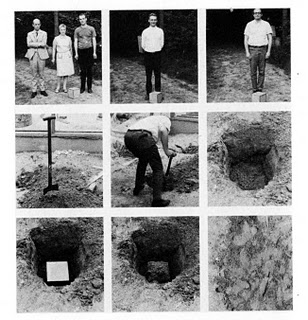14th September
Kinetic Art
Is the manifestation of the fascination with movement that defined modern art from Impressionism Onwards. It has its origins in Dadaism and Constructivism, both from the early 20th century. The Kinetic Art movements spans multiple decades and has its foot in many art movements due to the increased use of technology and modern science in art practices. It is art that relies on the presentation of motion or movement, which evolved from the inspiration taken from post world war technology. Kinetic art was born from the destruction caused by World War II, the constant use of machinery was something artists used to depict the beauty of movement and time. Kinetic Art helped remove the stigma of technology post war by showing viewers technology in new forms contrasted against the violent and harsh ways it was primarily used. An important artist from the Kinetic Art movement was Naum Gabo. He believed that art should have an explicit and functional value in society. He started off as an engineer and architect, he incoroporated cutting-edge technology from these fields into his mechanical sculptural constructions. He pioneered the idea of dissolving the boundaries between artistic and fictional processes. One of his greatest discoveries was the idea that negative space could be used to enhance the sculpture or work. One of his most important works was "Kinetic Construction (1920)", a free standing metal rod set in motion by an electric motor, which articulates a delicate wave pattern in the air. It emphasises the betray in the movement technology can make, as well as the negative space the rod creates around itself. However, Kinetic Art exploded into the mainstream and became an avant-garde after the 1955 Le Mouvement exhibition that was held in Paris. An artist that really pioneered this idea of movement was later contributor Bridget Riley. She created singular op paintings and moving optical illusions. She played with the interactions of colour and visual sensation. A piece of work that was monumental was her painting "Blaze (1964)" which infused black and white lines to create a vortex that burrows down into the core of the picture-plane. It is a perfect example of the way Riley used colour and shape to create incoherent movement and invoke feelings of seasickness. She remains one of the best post-war kinetic artists. Kinetic Art influenced other movements such as Minimalism and Conceptual Art because of the way that they pursued the same organic movement and natural visual effects.


https://www.theartstory.org/movement/kinetic-art/artworks/
https://www.theartstory.org/movement/kinetic-art/
https://www.theartstory.org/artist/gabo-naum/
Kinetica MuseumOur PickFeatures Kinetic Works by Contemporary Artists
Guggenheim: Kinetic ArtProvides a Brief Overview of the Movement and Examples of Kinetic Works from the Collection
Dadaism
Dadaism was an artistic movement and a literacy movement that began in 1916 in Zürich, Switzerland. The reaction to World War I was a major factor in the rise of Dadaism, as well as the countries nationalism that many people thought was the reason for the war. The key idea of Dadaism was to oppose the norms of bourgeois culture, as the frustration with snobby western art culture became an influence for all involved. The art created would often cause laughter because of the absurd and nonsensical aspects of the work. Artist would challenge the idea of meticulously planned art by incorporating chance into the way their art was created. This is shown through their persistent use of readymades, an object that could be bought and exhibited without much manipulation from the artist. One of the founders of Dadaism was Hans Arp, who was known for his organic and non-representational work. He was one of the first to take out thinking from the art and fully use chance and randomness to create work. As well as being a founder of Dada, he was a participant in Surrealism, and subsequently created a link between these two movements through his work. This can be seen in his collage "Collage with Squares Arranged According to the Laws of Chance (1916-17)", which utilised this idea of chance as he would drop pieces of paper onto a larger sheet and pasting them where they fell. This was highly unusual at the time and was a hallmark for Dada. Another artist that is tied to the Dadaism movement was Francis Picabia. His work was focused around challenging the norms of religion, law and morality. His work was mainly collages and painting, around the time of Dada forming, that incorporated text and scandalous imagery, which both shocked people and directly apposed the normal. A painting that directly challenged the idea of human nature and the soul was Picabia's Parade Amoureuse (1917) which incorporated machinery with the depiction of blended male and female bodies. It focuses on the emphasis of instinct and compulsion. He influenced artist like Andy Warhol and David Salle. Dadaism dissipated with the establishment of Surrealism but it would influence countless categories of contemporary and modern art for decades to come after it.


https://www.theartstory.org/movement/dada/
https://www.theartstory.org/artist/picabia-francis/
https://www.theartstory.org/artist/arp-hans/
https://www.theartstory.org/artist/arp-hans/artworks/
International Dada ArchiveProject by The University of Iowa Libraries
From Dada to Surrealism - ReviewBy Phillippe Dagen / The Guardian Weekly (UK) / July 19, 2011
Conceptual Art
Conceptual Art was a movement that originated in the mid 1960s. Its main focus was to highlight the importance of the ideas surrounding art instead of the artwork itself and explore ideas and communicate them quickly. That the instructions for the artwork are more important than the finished product or artwork. It was a mixture of different processes rather than a tightly cohesive movement. Conceptualism took many forms such as sculpture, performance, happenings and installations. Artists worked to push the boundaries of what could be called art, in terms of society's standards at the time. They realised that art was purely conceptual, and reduced the material presence of the artwork to a complete minimum, to which some call this the dematerialisation of art. Art became both physical and non-physical, and dismissed the idea that art needed to demonstrate a high level of skill. Artist Sol LeWitt published "Paragraphs on Conceptual Art" in 1968, which is considered by many the movements manifesto. He wrote "What the work of art looks like isn't too important. It has to look like something if it has a physical form. No matter what form it may finally have it must have started with an idea. It is the process of conception and realisation with which the artist is concerned." His idea to place the notion of concept before object is what set it apart from its predecessor movements, Dadaism and Minimalism. The social construct at the time was expanding and conceptual art took advantage of the broadening understanding of concept art. Previously mentioned artist Sol LeWitt was a key innovator with his work "Cube Buried Containing an Object of Importance but Little Value (1968)". Influenced by the deconstructed work by Josef Albers, Buried Cube was carried out in a local garden, with a series of photographs being the only proof the action took place. Without seeing the work or knowing what was inside, LeWitt relies on the idea, rather than the finished object itself. This work was produced before the manifesto was published and clerkly highlights the aim of conceptual art in its effectiveness of producing a different reaction depending on the person viewing it. Another artist that worked in this way was Robert Rauchesnberg, who was tied to the Neo-Dada and Abstract Expressionism movements. His work fits into this idea of idea over object, and is well aligned with Conceptualism's morals. His piece "Erased De Kooning Drawing (1958)" is a clear example of what conceptual art was about. Rauchesnberg acquired one of leading New York artist, Willem de Kooning drawings and erased the entire contents. It took him two months and over one hundred erasers to remove the drawing, de Kooning's drawing can still be seen as its heavily contrasted charcoal was deeply indented into the paper. The absent drawing is presented as an art object, designating the act of erasure as belonging to the realm of fine art. Rubbing out the drawing took the object out of the artwork and brought it back into its original idea form, meaning nothing outside itself. His work influenced many artists, especially Andy Warhol and Roy Lichtenstein.


https://www.theartstory.org/artist/lewitt-sol/artworks/
https://www.theartstory.org/artist/lewitt-sol/
https://www.theartstory.org/movement/conceptual-art/
https://www.theartstory.org/movement/conceptual-art/history-and-concepts/
https://www.theartstory.org/artist/rauschenberg-robert/
https://www.theartstory.org/artist/rauschenberg-robert/artworks/
Sol LeWitt at MoMABehind the Scenes: Installation of Focus
Minimalism
Minimalism originated in New York in the early sixties and was started by artists who renouncing current art that they deemed boring and academic. It represents truth and simplicity. Painters and sculptors from the Minimalism movement rejected overt symbolism and emotional content instead focusing on the materiality of the works. It spawned from the increasingly stagnating world of art, in which many American artists were becoming boring and repetitive. This frustration led to the boom of creative change in the New York art scene and the difference in work completed by artists there. Minimalist artists distanced themselves from Abstract Expressionism by removing suggestion and metaphor from their art completely. Most works forced the viewer to consider the space around the art work as the use of sleek geometric shapes often complimented negative space. Minimalism artists used industrial, easy to obtain materials to create their work, often working in brick and metal. Though the use of these materials viewers were led to experience gravity, weight, height and light as a martial presence. Minimalism was very tied to the work in Conceptual art as they both upended the notion that art had to have a specific meaning however the difference being that Conceptual art aimed to emphasise the idea behind an artwork, while Minimalism focused on exposing the essential components of the work by eliminating all non-essential forms. An artist who did this was Carl Andre, a founder and pioneer of the Minimalism movement. He was revolutionary because of his idea to create sculpture on the idea of sorting and placing instead of carving and constructing. His work used material that he saw on the streets, often being brick and different types of metals. His work focused on interrupting viewers movement in a gallery or capturing movement in subtle ways. An example of this would be "Lever (1966)" in which he laid a line of stacked bricks across the floor, projecting from the wall. This work changed they way viewers interacted with the gallery space as it now required a more thoughtful and complex approach. This work was completed with traditional building materials that needed no manipulation from the Andre. Fellow founder, Donald Judd was someone who also challenged the way viewers interacted with the work. His geometric sculptural shapes that he would design and get produce would sit directly on the floor, forcing the viewer to confront the sculpture. He would use factory materials like iron, steel and plastic to give his work a factory and industrialised aesthetic. This separated his work from Abstract Expressionism as it removed that personal touch. An example of this would be his 1980 work "Untitled". A steel and plexiglass sculpture of repeated suspended racks suggests a repetition of the viewers body. The two materials interact with each other to create different experiences depending on the way it's looked at. From the front the steel draws you in and creates a flat feeling, while when viewed from the side the steel juts into space. This work created a new way vocabulary way of producing art. Minimalism ended in the late 70s and gave birth to movements like Post-Minimalism and Earth Art.


https://www.theartstory.org/movement/minimalism/#nav
https://www.theartstory.org/artist/andre-carl/
https://www.theartstory.org/artist/judd-donald/artworks/#pnt_4
https://www.theartstory.org/artist/judd-donald/
https://www.theminimalists.com/minimalism/
https://www.tate.org.uk/art/art-terms/m/minimalism
Richard Serra on Charlie Rose, December 2013Our Pick
Carl Andre: Sculpture as Place, 1958-20102015 Dia:Beacon exhibition website
Modernism
Modernism was a global movement in society that was from the earlier twentieth century but its origins can be traced as far back as the industrial revolution in the mid eighteen hundreds. Before the 19th century, artwork was often commissioned by rich patrons to show wealth and status, but artists began to create work of their own on their own accord. It sought to create a new alignment with modern industry and art. Artists throughout history that utilised modern materials fall into the category of modernism. It was to represent the hopes of modern society throughout history. Many different styles and terms are tied to Modernism, a simple principle ties them to each other; A rejection of history and conservative values, innovation and experimentation with form. Modernism was driven by different social and political agendas throughout its history with most being utopian, and being tied to the ideal vision for human life. There have been many important Modernist artists throughout history however artist Egon Schiele completely changed the way self portraits and portraits were approached. The Austrian draughtsman, painter and printmaker embraced figural distortion and depicting unconventional beauty standards. He led the Expressionism movement but was a modernist in the way he used unconventional art methods and styles fuelled by skewed political ideals of the time. His strange depiction of erotica and sexual directness was completely removed from the norm and had never been seen in European art culture. His 1910 portrait "Self Portrait" depicted an intimate sitting position that eroticised the artists himself, a type of portrait which had virtually never been done with a male in Western art history. He expressed his anxiety through a combination of line and contour. The geometric shapes used to construct the figure was ahead of his time. Modernism is the advancement of art, art practices and the way people thought about art. Artist Andy Warhol can be thought as one of the most important Modernist artists, in the way he manipulated popular tastes. The commercial illustrator is acclaimed for his comic like, whimsical toned prints and illustrations. When the original and popular canvases of Abstract Expressionism had become predictable and cliche, the New York art scene was in a rut. He brought the underground style of pop art into the mainstream high art scene, it marked a new stage between high and low art forms. He brought together art and popular media by blurring the line between artist and celebrity, predicting the current way artists work in society. His work "Campbell's Soup I (1968)" sought to bring imagery back into the art scene. He chose a subject that was easily identifiable, and it was chosen for the New York ad market and was specifically designed for commercial success in both industry and art culture. He modernised and linked fine art and commercial art into something both visually appealing and artistically stimulating. His work both criticised and complimented the increasing problem with mass consumerism habits in society. Modernism has been a staple of art culture, which led on to movements like American Art and Post-Modernism.


https://www.tate.org.uk/art/art-terms/m/modernism
https://www.moma.org/learn/moma_learning/themes/what-is-modern-art/
https://www.theartstory.org/artist/schiele-egon/
https://www.theartstory.org/definition/modern-art/history-and-concepts/#nav
https://www.theartstory.org/artist/warhol-andy/
https://www.theartstory.org/artist/warhol-andy/artworks/#pnt_1
Bauhaus
The Bauhaus was arguably one of the most influential modernist school of the 20th century. Its approach to teaching art and its relationship between art, society, politics and technology had a major impact on European and American art years after its closure in 1933 due to pressure from the Nazi rule. Bauhaus was influenced by Art Nouveau and its many international connections, which impacted the style that artists took. The many styles allowed for an evolution in the way work was approached that focused on high craftsmanship. They sought to reunite the link between creativity and manufacturing. The schools faculty is seen as revolutionary figures that led the development of modern art and modern thought in art throughout Europe and the United States. Driven by the fear of the loss of arts social relevance and soulless modern manufacturing. Bauhaus reunited fine art and functional design, creating functional objects with the soul of artwork. Bauhaus abandoned many conventional approaches of fine art teaching but focused on the intellectual and theoretical thought behind the subject. Work was completed in many different styles and mediums like architecture, product design, painting, sculpture and photography. Despite the difference in material, these were approached in the same methodical way. They success of Bauhaus was seen more in the industrial areas of work such as furniture and product design. This paved the way for the stylish minimalism of the 60s and 70s. Designer, Marcel Breuer touched every part of three dimensional design. He studied at Bauhaus and quickly became part of the faculty, changing the way design would be looked at. He is one of the most recognisable designers and important architects of modern age. This was because he tied design to the soul. He was always an innovator, challenging the boundaries of new material. His design "Club Chair (Model B3) (1927-28)" would become one of the worlds most recognisable and iconic pieces of furniture. Using a bicycle was the paragon for the design, Breuer created the chair for mass production, using lightweight metal rods that were bendable without being brittle. The chair is broken down to its fundamental aspects, being both functional and simple. It was the first chair to use a bent steel frame. The chair was named after Wassily Kandinsky, a professor at Bauhaus and the rights were finally bought by American company Knoll in 1968, where it is still manufactured today. Faculty member at Bauhaus, Lázló Mohloy-Nagy was also a restless innovator and creative. His work tied sculpture and design so closely and gave it a technical, practical and experimental feel to it in one. He believed work had to be made by being dependent on modern technology. He was fascinated with light and vision, spreading into the many mediums that he explored. He was one of the first to encourage the use of photography as a creative outlet, he encouraged this new form of media. His work "Puppen, Ascona (1926)" shows his interest in high contrast artistic photography that had previously been unseen. He believed that the unconventional, new and radical angles would foster new perceptions of the world around the viewer. The straight clean lines and harsh shadows seem reminiscent of architectural and design photography while the limbless dolls push the work into the realm of surrealism. The criss cross of lines "removes the toy into the realm of the fantastic. Moly-Nagy went on to establish the institute for Design in Chicago. Bauhaus influenced movements such as Modernism and Minimalism.


https://www.theartstory.org/movement/bauhaus/
https://www.theartstory.org/artist/breuer-marcel/
https://www.theartstory.org/artist/breuer-marcel/artworks/#pnt_1
https://www.theartstory.org/artist/moholy-nagy-laszlo/artworks/
https://www.theartstory.org/artist/moholy-nagy-laszlo/artworks/#pnt_10
https://www.theartstory.org/artist/moholy-nagy-laszlo/
Comments
Post a Comment